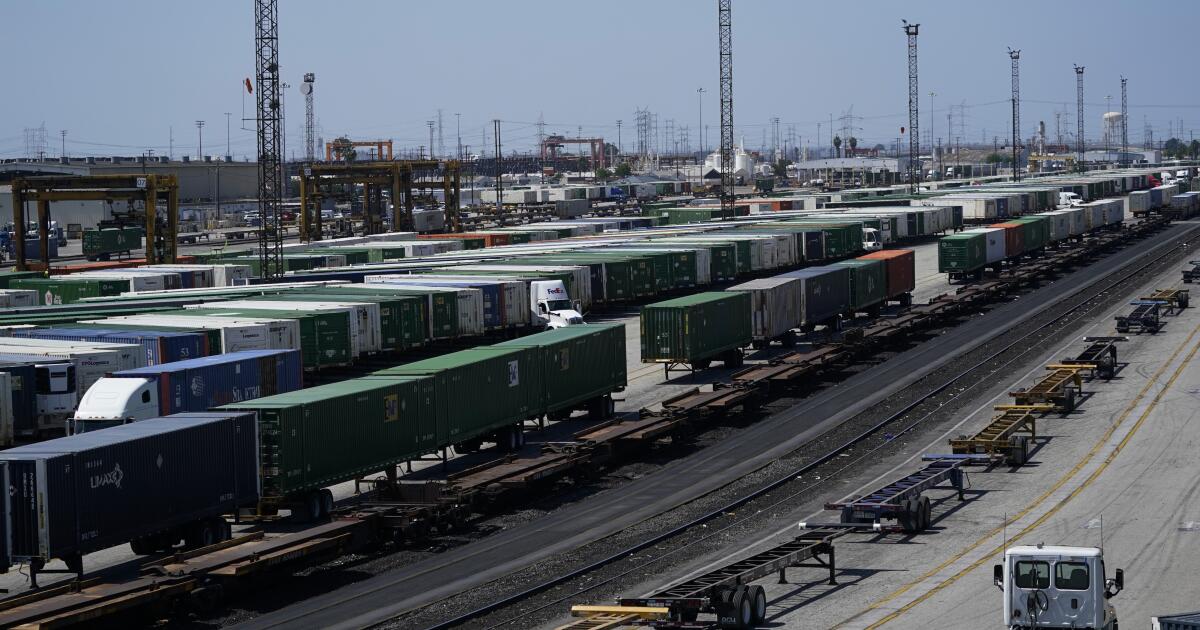Southern California air regulators have adopted a first-of-its-kind rule to curb smog-forming pollution from freight trains and cargo trucks that serve the region’s rail yards.
The South Coast Air Quality Management District’s governing board voted 12-0 on Friday to require rail yard owners and operators, including BNSF Railway and Union Pacific Railroad, to aggressively reduce lung-irritating nitrogen oxides emissions between 2027 and 2050.
The region’s rail yards produce nearly 22 tons of nitrogen oxide emissions a day, about 9% of all smog-forming pollution in the air basin.
The new regulation — applicable to about 25 rail yards in Greater Los Angeles — would help curb regional rail yard pollution roughly 80% by 2036. Once implemented, the rule is expected to avert 300 premature deaths and 2,100 hospitalizations each year, according to the air district, improving air quality in communities that border rail yards, including Wilmington and San Bernardino.
“While there is no single rule or regulation that can achieve federal air quality standards on its own, today’s adoption is a big step in the right direction,” said Vanessa Delgado, the air district’s governing board chair. “There are so many communities, parks and schools that are surrounded and affected by sources associated with rail yards that will directly benefit from today’s action. We will continue to reduce emissions where we are able because that is what our communities deserve.”
Before the vote, dozens of community members and environmental advocates voiced their support of the rule, many wearing shirts that read, “My heart is in your hands,” alluding to the cardiovascular effects associated with breathing air pollution. Many hoped this regulation could mark a new beginning for communities near rail corridors.
“This is about correcting a historical injustice,” said Samuel Brown-Vazquez, who spoke at Friday’s public hearing. “Where I live in Avocado Heights, our community was ravaged by the creation of the rail yard and the impacts they had.”
The regulations intend to clean up some of the most stubborn sources of pollution within Southern California’s busy goods movement sector, most notably diesel-powered trains.
Train emissions — about 70% of all rail yard pollution — have remained largely unchanged over the past decade, partly because the rail industry has not purchased new locomotives with cleaner engines, according to the air district.
The air district new rule is expected to work in tandem with state Air Resources Board rules governing locomotives and trucks. But the new regulation is necessary because previous state rules for trucks have not been as effective at reducing pollution in Southern California compared with other parts of the state, according to the air district officials.
The rail yard rule will ensure that Southern California’s rail yard emission reductions are on par with state rules.
However, the new emission reduction rule can become effective only if the U.S. Environmental Protection Agency signs off on the region’s smog plan and approves the state regulations for locomotives and truck fleets.
Curt Hagman, an air district governing board member and San Bernardino County supervisor, expressed concern about the feasibility of achieving these reductions, considering the necessary improvements to the power grid and electric infrastructure to accommodate cleaner rail yards.
Wayne Nastri, the air district’s executive officer, said a recent historic $500-million EPA grant could help. He also noted there may be flexibility to waive penalties if rail yards encounter delays or difficulties.
“There has been tremendous effort at the state level to make sure that we have the energy capacity to meet the growing needs,” Nastri said. “But the challenge that’s been identified more of lately is that last facility hookup, making sure that the facilities either have the substations, the circuits, the transformers and the time it takes to process that.”
In Southern California, at least three agencies regulate air quality: the South Coast Air Quality Management District, which regulates facilities; the California Air Resources Board, which regulates in-state cars and trucks; and the EPA, which regulates trains, aircraft and ships.
Because some of Southern California’s largest polluters are federally regulated, the local air district has attempted to work around its own limitations by requiring the facilities to offset pollution. The air district’s first rules of this kind, adopted in 2021, established requirements for large warehouses to mitigate the pollution from the truck traffic they attract.
The rail yard rule is the second policy of its kind by the air district.
Although the rule notably will not apply to rail yards at the ports of Los Angeles and Long Beach, the air district is drafting a similar proposal to reduce emissions at the ports complex, the largest fixed source of smog-forming pollution in the region.
